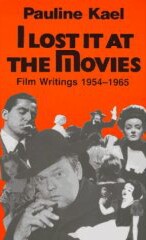Is There a Cure for Film Criticism? (or, Some Unhappy Thoughts on Siegfried Kracauer's Theory of Film: The Redemption of Physical Reality) (excerpts)
 There is, in any art, a tendency to turn one's own preferences into a monomaniac theory; in film criticism, the more confused and single-minded and dedicated (to untenable propositions) the theorist is, the more likely he is to be regarded as serious and important and "deep" - in contrast to relaxed men of good sense whose pluralistic approaches can be disregarded as not fundamental enough.
There is, in any art, a tendency to turn one's own preferences into a monomaniac theory; in film criticism, the more confused and single-minded and dedicated (to untenable propositions) the theorist is, the more likely he is to be regarded as serious and important and "deep" - in contrast to relaxed men of good sense whose pluralistic approaches can be disregarded as not fundamental enough.Often the worst and most embarrassing part of a film is the accidental, the uncontrolled, the amateurish failure which exhibits its unachieved intentions; and the finest moment may be a twitch of the actress's cheek achieved on the fiftieth take. There are accidents which look like art and there is art that looks accidental; but how can you build an aesthetic on accident - on the ripple of the leaves?... How can you say 'accidents were the very soul of slapstick'? In comedy what looks accidental is generally the result of brilliant timing and deliberate anarchy and wild invention and endless practice.
The look of so many good movies during the period [Kracauer] was gestating this book becomes his definition of cinema itself.
"Film," he tells us, "gravitates towards unstaged reality" and "the artificiality of stagy settings or compositions runs counter to the medium's declared preference for nature in the raw." How and when did the medium declare its preference, I wonder? The trouble with this kind of Hegelian [philosophy of Hegel in which the dialectic of thesis, antithesis, and synthesis is used as an analytic tool in order to approach a higher unity or a new thesis] prose is that the reader is at first amused by what seem to be harmless metaphors, and soon the metaphors are being used as if they were observable historical tendencies and aesthetic phenomena, and next the metaphor becomes a stick to castigate those who have other tastes, and other metaphors.
The cruiser Potemkin and the oil derrick in Louisiana Story, are less feasible on stage, but how does that make them more cinematic than something which is easy to put in a theater? Both are, incidentally, much less interesting objects on the screen than they are generally asserted to be: the exciting action in Potemkin has little reference tot he cruiser itself (extras can run around on a stage, too) . . . Who started this divide and conquer game of aesthetics in which the different media are assigned their special domains like salesmen staking out their territories - you stick to the Midwest and I'll take Florida?
Film aestheticians are forever telling us that when they have discovered what the motion picture can do that the other arts can't do, they have discovered the "essence," the "true nature" of motion picture art. It is like the old nonsense that man is what differentiates him from the other animals . . . And what motion picture art shares with other arts is perhaps even more important than what it may, or may not, have exclusively. . . Except for the physical presence of the actors in a theater, there is almost no "difference" between stage and screen that isn't open to question; there is almost no effect possible in one that can't be simulated, and sometimes remarkably well achieved, in the other.
Perhaps the most lovable side of Kracauer is his desperate attempt to make musicals, which he obviously adores, fit his notion of cinema as nature in the raw. . . As if our delight in the performance of a song or dance depended on the degree to which it grew out of the surrounding material - as if our pleasure had to be justified! This is a variant of the pedagogical Puritan notion that you mustn't enjoy a poem or a story unless it teaches you a lesson: you mustn't enjoy a movie unless it grows out of "nature." . . . Phew! Our pleasure in song and dance, as in motion picture itself, is in the ingenuity with which man uses the raw material of his existence - not in the raw material itself, or in a visible link with it. . . It is this clumsy effort to make things look "natural" instead of accepting the stylization of song and dance which helps to make so many musicals seem simpering and infantile.
In the fall of 1961 New Politics, Ernest Callenbach writes "a letter to a young film maker" and says "Get thee to Cuba, and after that to Latin America elsewhere, and then Africa." Would the same advice be given to a young writer or painter? Why are moviemakers obliged to make history? . . . But suppose the young film maker doesn't know Spanish, can't stand the sight of blood, was drawn to the elliptical scenario on the uneventful life of Emily Dickinson? He'll probably make a terrible movie, but surely the first prerogative of an artist in any medium is to make a fool of himself.
Films are not made by cameras, though many of them look as if they were, just as a lot of dialogue sounds as if it were written by typewriters.
Labels: Pauline Kael
1 Comments:
I agree that film criticism can sometimes become too focused on theory and forget about appreciating individual moments in a movie.
Post a Comment
<< Home